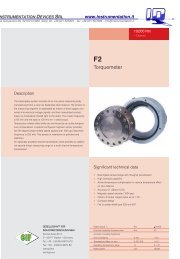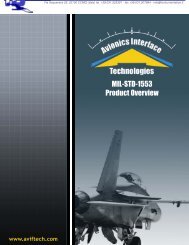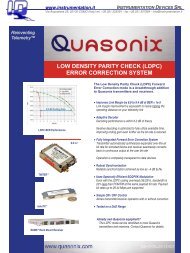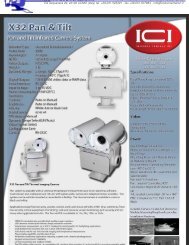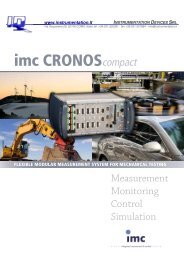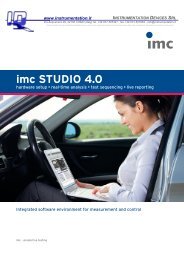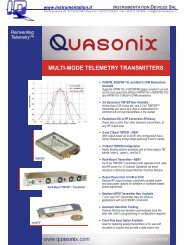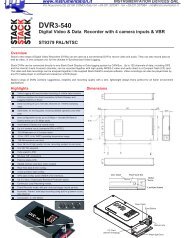DATA Acquisition - Instrumentation Devices
DATA Acquisition - Instrumentation Devices
DATA Acquisition - Instrumentation Devices
You also want an ePaper? Increase the reach of your titles
YUMPU automatically turns print PDFs into web optimized ePapers that Google loves.
PRODUCT GUIDE<br />
<strong>DATA</strong> ACQUISITION<br />
KAM-500<br />
Reliable, Compact, Modular,<br />
High Performance DAUs<br />
LEADERS IN AIRBORNE <strong>DATA</strong> ACQUISITION<br />
www.instrumentation.it<br />
INSTRUMENTATION DEVICES SRL<br />
Via Acquanera 29, 22100 COMO (Italy) tel. +39.031.525391 - fax +39.031.507984 - info@instrumentation.it
<strong>DATA</strong> ACQUISITION<br />
About ACRA CONTROL<br />
ACRA CONTROL is a world leading supplier of airborne data acquisition networks and recording systems and<br />
real-time data processing ground stations to the aerospace industry. With two decades of experience, our<br />
reputation is built on reliable and innovative COTS products – a result of sustained investment in R&D and<br />
engineering expertise. This combined with AS9100 quality processes and strong program management ensures<br />
top class capabilities in aerospace projects of any size. ACRA CONTROL’s customers include all of the major<br />
aerospace prime contractors and test agencies with products supplied to over 300 different platforms in 40<br />
countries worldwide.<br />
The ACRA CONTROL Difference<br />
ACRA CONTROL’s KAM-500 data acquisition units (DAUs) are driven by hardwired finite state machines making<br />
them extremely reliable. Their compact, low power design makes them ideal for installing in locations that have<br />
limited space. ACRA CONTROL’s DAUs operate in the harshest environments thanks to their MIL-SPEC<br />
environmental ruggedness.<br />
There are over a hundred modules available that support advanced signal conditioning, avionics bus monitoring,<br />
video/audio compression, integrated data logging and multiple output formats; all of which adhere to the “any<br />
module, any chassis, in any combination” rule. This has many benefits including a simple upgrade path and<br />
enabling highly customized systems to be built using COTS product.<br />
The KAM-500 was designed to be ‘network native’ and gathers data with precision synchronization even across<br />
a large distributed system. It can operate in many industry-standard topologies, such as Ethernet, PCM and<br />
CAIS. The KAM-500’s well-proven backplane uses a 100% digital architecture to support a throughput of up to<br />
64Mbps (4Msps with 16 bits per sample) per chassis, aggregating up to gigabit per second throughput for a<br />
network distributed system.<br />
The KAM-500 is based on open and mature standards and protocols for transmission, system synchronization,<br />
management and configuration. The chassis’ modularity yields an exceptionally long useful life with a direct<br />
upgrade path to new technologies that ensures the solution is future proof.<br />
A complete suite of setup and management software that significantly improves setup times completes the<br />
solution by providing integrated tools and an intuitive display environment.<br />
Features<br />
Reliable and rugged - Driven by hardwired finite state machines; operates in harsh environments<br />
Compact and low power - Ideal when space and power are limited<br />
High performance - High system throughput and data integrity<br />
COTS modular design - 100+ plug-in modules fit all chassis<br />
Powerful software - Intuitive, fast set-up and programming; Tight integration with display/analysis<br />
1
PRODUCT GUIDE<br />
One Product, Many Applications<br />
ACRA CONTROL’s flexible data acquisition systems are used in a wide range of applications including<br />
Flight Test <strong>Instrumentation</strong><br />
ACRA CONTROL provides the most widely-installed<br />
Flight Test <strong>Instrumentation</strong> (FTI) system in the world<br />
with more flight hours than any other. Proven COTS<br />
hardware, short delivery times, tightly integrated<br />
software and a large dedicated team of application<br />
engineers lowers risk and saves time on FTI projects.<br />
Aircraft Usage Monitoring<br />
The rugged, compact recorder systems from ACRA<br />
CONTROL benefit aircraft usage monitoring<br />
applications with their flexible interface support and<br />
optional built-in test and solid-state recording. Open<br />
data formats facilitate easy data export to data<br />
analysis software.<br />
Remote Data Concentrator<br />
The KAM-500’s rugged construction and high channel<br />
count to size ratio makes it perfect for acquiring data<br />
from remote locations for delivery to a central point<br />
over a single cable yielding savings in cable weight<br />
and reducing installation design complexity.<br />
Launch Vehicle <strong>Instrumentation</strong><br />
The KAM-500 has proven its reliability and<br />
performance on launch vehicle applications such as<br />
United Launch Alliance’s Delta II and SpaceX’s Falcon<br />
9. Its design is suitable due to its small size, high<br />
channel density and launcher specific benefits such as<br />
transmission black-out buffers for delayed data<br />
transmission.<br />
Flight Data <strong>Acquisition</strong> for Crash Recorders<br />
The KAM-500’s high reliability, live on power-up<br />
functionality and flexible interface support ensures<br />
highly configured systems can be built and later<br />
modified using off the shelf modules that remove the<br />
cost of bespoke designs.<br />
Communications Interface Unit (CIU) for<br />
Unmanned Aerial Vehicles (UAVs)<br />
The KAM-500 can act as a CIU, interfacing between<br />
the Air Data Terminal (ADT) and a host of platform<br />
and payload electronics. Data translation, signal<br />
processing and conditioning, encoding / decoding and<br />
recording can all be delivered in a single, adaptable<br />
unit.<br />
2
<strong>DATA</strong> ACQUISITION<br />
Reliable <strong>Acquisition</strong><br />
KAM-500 data acquisition is based on a simple and robust concept – the ‘acquisition cycle’. Finite state machines<br />
are implemented on fixed function FPGAs (Field Programmable Gate Arrays), not software dependent<br />
microprocessors. The FPGA is configured to repeatedly perform the same set of actions so that hardware performs<br />
reliably and in a completely deterministic manner– ‘works once, works always’.<br />
<br />
<br />
<br />
No software, stack or microprocessor<br />
No real-time decisions or interrupts<br />
No operating system (no boot up time)<br />
No analog multiplexers =<br />
simultaneous sampling + no crosstalk<br />
The hardware has been designed for reliability<br />
No potentiometers, jumpers or relays<br />
No SIMS (programmable filters)<br />
I 0<br />
I 1<br />
Out<br />
High Performance<br />
The KAM-500’s high performance is achieved using an all-digital backplane with a throughput of up to 64Mbps<br />
(4Msps with 16 bits per sample). The KAM-500 supports hundreds of analog channels in a single, stand-alone chassis.<br />
For distributed systems the number of channels increases to thousands. All analog modules have high data integrity<br />
as<br />
Every analog channel has its own antialiasing filter, instrumentation amp at least 16 bit ADC and<br />
programmable digital filter<br />
Digital filtering is applied using FIR and IIR techniques for a wider choice of sampling rates, more accuracy<br />
and repeatability as well as immunity to temperature drifts<br />
All parameters are sampled independently of transmission<br />
Time correlation of sampled data is straightforward as parameters sampled at the same rate are sampled at<br />
exactly the same point in time<br />
Simultaneous sampling occurs across the complete system in every card in every chassis making it<br />
unnecessary to realign or interpolate samples during analysis<br />
Sel<br />
PSU<br />
Generates +5, +/-12V, +/-7V<br />
Isolated/filtered/ protected<br />
BACKPLANE CONTROLLER<br />
with data encoder<br />
PCM or Ethernet<br />
USER SLOTS<br />
Any module in any slot<br />
3, 6, 9, 13 as standard<br />
DIGITAL BACKPLANE<br />
Synchronous Clock, at 8MHz, Address and Data lines, Read/Write Strobes<br />
3
PRODUCT GUIDE<br />
Compact, Low Power<br />
The compact size and low power requirements of the KAM-500 make it a perfect fit for the majority of airborne<br />
applications. The all-digital system-level design and well-proven, stable and mature backplane architecture, together<br />
with the availability of a wide range of module-level core logic, combine to ensure that no challenge is too great<br />
where the program merits the customization of COTS technology and the schedule can accommodate the<br />
corresponding lead-times.<br />
Standard Chassis<br />
3, 6, 9, 13 user slots<br />
Single units to large distributed systems<br />
3U 6U 9U 13U<br />
Alternative Chassis<br />
Compact units in variable sizes and form factors<br />
5F<br />
TKAM *<br />
1F *<br />
microKAM<br />
12R<br />
3F<br />
4L<br />
Refer to Mechanical Specifications on page 11<br />
* design concepts<br />
Modular, Future Proof<br />
A key concept behind KAM-500 is “any module, any chassis, in any combination”. Modules or chassis can be added<br />
to the system or individually replaced. There are over a hundred modules and variants available and chassis can be<br />
built with any mixture of modules – analog, digital, bus etc. – to meet the specific needs of a program. This<br />
modularity means inventory requirements are minimized and it is easy to modify or upgrade a system by simply<br />
replacing modules that interface to<br />
<br />
<br />
<br />
<br />
Sensors<br />
Avionics buses<br />
Audio / video<br />
Serial / parallel data<br />
The ACRA CONTROL solution is highly future proof with new modules added continuously every year that work<br />
with the same KAM-500 chassis. This is reinforced with the proven, easy migration path to new networking and<br />
sensor technologies such as smart and wireless sensor networks.<br />
4
<strong>DATA</strong> ACQUISITION<br />
Open<br />
ACRA CONTROL’s product design is based on the iNET-X framework which leverages<br />
open standards for systems management, time synchronization, Data <strong>Acquisition</strong> Unit<br />
(DAU) configuration and data transmission. It is a complete framework that has been<br />
developed around the core recommendations and technologies outlined in the CTEIP<br />
Integrated Network Enhanced Telemetry (iNET) standard ensuring interoperability for<br />
instrumentation networks. In essence iNET-X<br />
<br />
<br />
<br />
<br />
eXtends iNET to ensure high performance and network coherency<br />
eXcels at providing ease of set-up and management for networked DAS<br />
eXceptionally comprehensive statement on protocols and standards<br />
ensuring a future proof system<br />
eXtremely reliable and rugged hardware specification<br />
One key aspect of the iNET-X framework is the metadata layer which is defined as XidML. This is an open XML<br />
metadata standard for the aerospace community that has been developed and published by ACRA CONTROL in<br />
cooperation with industry partners. It provides a vendor-neutral hardware configuration platform that describes how<br />
data is acquired, processed and packaged for transmission, storage or reproduction and facilitates device<br />
interoperability.<br />
Rugged<br />
ACRA CONTROL’s products are designed to operate in the harshest environments for example rotor hubs, engine<br />
casings, fast jet wings and solid rocket boosters. The modules are rugged by design e.g. their small form factor is<br />
inherently vibration resistant. The chassis are fully environmentally qualified for the aerospace environment – please<br />
refer to the environmental specifications section for details. A limited set of modules and chassis are available to<br />
operate in extreme temperatures between -55 to 105ºC, for example on engine casings or launch vehicles.<br />
Common Product Features<br />
User Modules<br />
Standard Front Panel<br />
Power Supply<br />
Controller<br />
2 Mbytes of EEPROM<br />
Non-volatile Logic<br />
Standard Backplane<br />
5
PRODUCT GUIDE<br />
Bus Monitors<br />
The avionics busses ARINC-429 and high speed MIL-STD-1553 have been joined by commercial standards such as<br />
Ethernet, CAN-bus and FireWire. ACRA CONTROL provides ‘Parsers’, ‘Snarfers’ and ‘Packetizers’ to monitor a wide<br />
range busses in a standardized manner without interfering with the busses operation.<br />
1<br />
Bus Parser Snarfer Packetizer<br />
requires external device<br />
AFDX<br />
<br />
Parser - Extracts specific data from a<br />
bus and places it into defined words<br />
ARINC-429 <br />
along with status information. Data is<br />
ARINC-573/717<br />
<br />
triple buffered to ensure the data remains<br />
coherent. A MIL-STD-1553 parser is<br />
ASCB-D 1<br />
sometimes referred to as IRIG-106<br />
CAIS<br />
<br />
Chapter 4 monitor.<br />
CAN-bus<br />
<br />
Snarfer – Places traffic and tags, along<br />
CCDL / MCDL<br />
<br />
with content identifiers, into a FIFO that<br />
CSDB<br />
<br />
ensures data is not lost if read fast<br />
EF-2000 FCS<br />
<br />
enough. For MIL-STD-1553 snarfing is<br />
Ethernet <br />
sometimes referred to as Chapter 8 or<br />
All-bus monitoring.<br />
FiberChannel 1<br />
FireWire<br />
<br />
Packetizer – Coherently embeds<br />
IRIG 106 PCM <br />
multiple whole messages / frames /<br />
packets of various lengths in an IP packet.<br />
MIL-STD-1553 Because traffic and tags can be inferred<br />
Panavia <br />
from the location in the packet payload,<br />
content identifiers are not required and<br />
RS-232/422/485 <br />
therefore less overhead / bandwidth is<br />
S200 beta mode FireWire <br />
required. There are also overhead savings<br />
with respect to time and status<br />
Serial data bus<br />
<br />
information which can be IP packet wide.<br />
STANAG-3910<br />
<br />
TTP bus <br />
Transmitters<br />
ACRA CONTROL’s transmitter modules encode data into a format suitable for transmitting to an external source e.g.<br />
another DAU, a recorder or an RF transmitter. Any chassis can transmit one or more of the following standards:<br />
ARINC-429 / 573 / 717, CAIS, Ethernet, IRIG 106 PCM, MIL-STD-1553, RS-232/422/485. Our compiler ensures that<br />
transmission occurs independently of data acquisition.<br />
Ethernet transmitters with aperiodic packet support do not transmit empty IP packets. PCM encoders designed for<br />
PCMoIP applications have aperiodic packet support and behave very like CCSDS encoders except that any group of<br />
words in the PCM frames can be allocated to a Packetizer.<br />
6
<strong>DATA</strong> ACQUISITION<br />
Network Native<br />
ACRA CONTROL has developed reliable high performance Ethernet interface modules and rugged aggregators and<br />
switches that allow the ‘network native’ KAM-500 to be interconnected in an Ethernet network. In such a network,<br />
setup, data acquisition and synchronization occurs over a single Ethernet connection, leading to significant savings in<br />
wiring complexity and weight.<br />
Standard protocols are used for programming (TFTP), health status monitoring (SNMP) and synchronization (IEEE<br />
1588). The managed switches transmit IEEE 1588 PTP packets to synchronize a system to better than 100ns, even<br />
across large distributed systems. There is no adaptive or dynamic switch behavior as the Ethernet data output of the<br />
DAU is predictable and known in advance. This deterministic acquisition and transmission facilitates coherency.<br />
Data from an Ethernet KAM-500 is optimally packetized for Ethernet transmission and recording but can be also be<br />
converted in many other industry standard protocols. This facilitates hybrid system e.g. PCM DAUs can be integrated<br />
into an Ethernet system or Ethernet data can be converted to PCM for telemetering.<br />
Flexible Network Configuration<br />
PCM to Ethernet Link<br />
Time Source<br />
Programming<br />
Ethernet<br />
PCM<br />
Time<br />
Prog<br />
ACRA CONTROL<br />
DAUs<br />
IP Recorder<br />
Managed<br />
Grandmaster<br />
Ethernet to PCM Bridge<br />
Unmanaged<br />
Aggregator<br />
7
PRODUCT GUIDE<br />
DAS Studio<br />
DAS Studio is ACRA CONTROL’s hardware setup and<br />
management software that has been developed using<br />
feedback from the data acquisition community which ACRA<br />
CONTROL has been supporting for two decades. It has been<br />
designed to save time in entering, reviewing and validating<br />
setup information and to ensure that instrumentation is<br />
correctly configured. DAS Studio provides hardware discovery,<br />
setup, programming, validation and reporting in a single<br />
integrated environment.<br />
The software is optimized for multi-core platforms with a<br />
multi-threaded architecture and parallel processing. This high<br />
performance means that system validation and programming<br />
is performed in minutes or even seconds.<br />
The integrated environment allows status, discovery,<br />
programming and other tools to be accessed without having to<br />
exit and launch another application. The user interface is simple<br />
and easy to learn with data rich tables and a consistent look that<br />
cuts through the complexity of configuring a data acquisition<br />
system.<br />
<br />
<br />
<br />
<br />
<br />
<br />
<br />
<br />
<br />
System automatically discovers interconnected<br />
devices and manages inter-chassis communication<br />
Seamlessly integrate 3 rd party equipment<br />
View how the system is configured at a glance<br />
Change thousands of settings simultaneously<br />
Re-use of proven configurations<br />
Rapid system programming via XidML task file<br />
Edit frames using a visual editor with custom<br />
parameter color coding and zoom and pan functions<br />
Dynamically check for errors<br />
Generate a HTML report from XidML files<br />
8
<strong>DATA</strong> ACQUISITION<br />
Added Value Applications<br />
Balance: automate laborious tasks<br />
Automatically balance thousands of strain gages<br />
Days of work reduced to minutes<br />
Preflight: accelerate testing<br />
Compare a saved snapshot file with a system and discover differences<br />
Check the state of the chassis by running self-test and report findings<br />
Assist flight technicians in determining if a system is ready for flight<br />
Shunt: gain preflight confidence<br />
For preflight confidence checks<br />
Simulate the shunting resistance across the bridge of a strain gage<br />
Quicklook<br />
Quicklook is the latest version of ACRA CONTROL’s real-time<br />
data visualization software. It is based on GS Works and allows a<br />
'quick look' at data to get instant feedback on the onboard<br />
configuration without needing a full ground station setup -<br />
perfect for lab-bench or pre-flight testing. It has direct XidML<br />
support, features event marking and test points and drag and<br />
drop functionality for display set-up and parameter viewing - all<br />
embedded in one tool. There is a three-minute scroll back feature<br />
for instant recall, so you can rewind in real-time to examine<br />
interesting data. The configuration can be exported to GS Works.<br />
9
PRODUCT GUIDE<br />
Related Products<br />
GS Works<br />
GS Works is a complete real-time and post-test display and analysis software<br />
suite. ACRA CONTROL’s products are tightly integrated with GS Works<br />
through common metadata meaning it uses all the parameter information<br />
entered in DAS Studio.<br />
<br />
<br />
<br />
<br />
Tightly integrated with ACRA CONTROL’s products<br />
Extensive data capabilities include every data point being cached to disk allowing scroll back of the data<br />
through the time history while continuing to store data in real-time<br />
Powerful time and frequency domain analysis available, e.g. derived equations, digital filtering, bode analysis<br />
and FFT transforms<br />
Displays, data, video and analysis techniques can be built over multiple monitors, tested and saved with little<br />
effort at any time during the mission or at the engineer's desktop<br />
Network Switches<br />
ACRA CONTROL manufactures rugged unmanaged aggregators and<br />
managed grandmaster switches with a variety port and speed<br />
configurations. The managed switches transmit IEEE 1588 PTP packets to<br />
synchronize a system and allow users to customize the number of DAU and<br />
aggregator ports to suit varied applications. A console port is available for<br />
programming and also functions as an aggregator port. Please refer to the<br />
Networks Product Guide for further details.<br />
Recorders<br />
ACRA CONTROL’s recorders are stand-alone compact, rugged units that<br />
record data directly from an Ethernet network. They support IRIG/GPS time<br />
synchronization and have removable CompactFlash® or SATA solid-state<br />
drive storage options. The SSR-500 range also features modular data<br />
acquisition capabilities. Please refer to the Recorders Product Guide for<br />
further details.<br />
Ground Stations<br />
ACRA CONTROL provides sophisticated ground station systems based on<br />
cutting edge bit synchronizer, Smart Source Selector and decommutator<br />
technology. The resulting systems significantly improve signal reception and<br />
increase data throughput. They offer an end to end solution from receiver to<br />
processed data with tightly integrated hardware and software. Please refer to<br />
the Ground Stations Product Guide for further details.<br />
10
<strong>DATA</strong> ACQUISITION<br />
Operational Specifications<br />
Electrical Specifications<br />
Input Voltage 18-40 VDC, 28 VDC (typical)<br />
Power<br />
Efficiency<br />
Note<br />
1.5 - 3 W per module (excludes<br />
excitation)<br />
75% (typical)<br />
Power supplies are designed to meet<br />
requirements of MIL-STD-704E<br />
Configurations<br />
The configuration for the standard KAM-500 chassis are as<br />
follows:<br />
Chassis Size 3, 6, 9, 13 user slots<br />
System Size Up to 64 synchronous chassis per<br />
system<br />
Throughput Up to 4 Msps<br />
System setup Microsoft Windows XP and 7<br />
Dual-core processor, 2GB RAM recommended<br />
DAS Studio Setup and Management software<br />
Time<br />
GPS and IRIG-B time modules are available for time code<br />
and navigation data<br />
<br />
<br />
1µs time resolution, outputs 1pps or 10pps pulses<br />
Navigation data such as position, altitude, velocity, and<br />
heading are available as individual parameters<br />
Output Options<br />
The KAM-500 can output data in a number of formats using the<br />
appropriate modules - consult factory and data sheets for<br />
details. Output options include<br />
IRIG-106 PCM<br />
100Base-T Ethernet<br />
Auxiliary PCM with Pre-Mod. Filter, Digital & voltage<br />
drivers<br />
ARINC 429/573/717<br />
MIL-STD-1553<br />
CAIS controller<br />
Standard Chassis<br />
Chassis User Slots Height Length Width<br />
CHS/03U 3 3.88" (98.5mm) 5.51” (140mm) 3.15" (80mm)<br />
CHS/06U 6 3.88" (98.5mm) 7.17” (182mm) 3.15" (80mm)<br />
CHS/09U 9 3.88" (98.5mm) 8.82” (224mm) 3.15" (80mm)<br />
CHS/013U 13 3.88" (98.5mm) 11.02” (280mm) 3.15" (80mm)<br />
Alternative Chassis<br />
Chassis User Slots Height Length Width<br />
microKAM 2 1.86” (47.3mm) 4.92” (125mm) 1.99” (50.8mm)<br />
TKAM* 7 2.5” (63.5mm) 11.00” (279.4mm) 2.5” (63.5mm)<br />
CHS/01F* 1 1.41” (36mm) 4.78” (121.5mm) 2.51” (64mm)<br />
CHS/03F 3 3.31” (84.2mm) 4.78” (121.5mm) 2.51” (64mm)<br />
CHS/05F 5 4.62” (117.5mm) 5.51” (140mm) 3.92” (92mm)<br />
CHS/04L 4 3.88" (98.5mm) 9.52” (242mm) 1.6” (40mm)<br />
CHS/012R 13 3.88" (98.5mm) Annular 9.84" (250mm)<br />
11<br />
* design concepts
PRODUCT GUIDE<br />
Environmental Specifications<br />
Operating Temperature<br />
MIL-STD-810F Methods 501.4 and 502.4 Procedure II<br />
-40°C to 85°C, at least 4 hours after stabilization<br />
Storage Temperature<br />
MIL-STD-810F Methods 501.4 and 502.4 Procedure I<br />
-55°C to 105°C, at least 4 hours after stabilization<br />
Altitude<br />
MIL-STD-810F<br />
Method 500.4 Procedure II<br />
Maximum pressure of 115Kpa (1150mbar) and a minimum<br />
pressure of 3.6Kpa (36mbar)<br />
Rapid Decompression<br />
MIL-STD-810F Method 500.4 Procedure III room ambient to<br />
3.6Kpa at a rate of 218Kpa/minute (2180mbar/min.)<br />
Explosive Decompression<br />
MIL-STD-810F Method 500.4 Procedure IV<br />
Unit unpowered and a pressure change from 2,438m (8000ft) to<br />
12,192m (40,000ft) was achieved in 78.4ms<br />
Shock<br />
MIL-STD-810F Method 516.5 Procedure V - modified 100g,<br />
11ms, terminal peak sawtooth 12 (two in each direction of three<br />
mutually perpendicular axes)<br />
Sinusoidal Vibration<br />
MIL-STD-810F Method 514.5 Procedure I<br />
Frequency Range 10 - 2000Hz<br />
Amplitude 10g<br />
Sweep rate One octave per minute<br />
Random Vibration<br />
MIL-STD-810F Method 514.5 Procedure I<br />
60 minutes per axis Random Endurance, 17grms<br />
0.04g2/Hz from 15 to 89.2Hz<br />
4dB/octave from 89.2 to 300Hz<br />
0.2g2/Hz from 300 to 1000Hz<br />
-6dB/octave from 1000 to 2000Hz<br />
10 minutes per axis Random Endurance, 33grms<br />
Frequency range 15-2000Hz<br />
Spectrum 0.04g2/Hz from 15 to 30.7Hz<br />
4dB/octave from 30.7 to 300Hz<br />
0.83g2/Hz from 300 to 1000Hz<br />
-6dB/octave from 1000 to 2000Hz<br />
Acceleration Operational<br />
MIL-STD-810F Method 513.5 Procedure II<br />
16.5 in each direction of three mutually perpendicular axes<br />
Duration Minimum of one minute in each direction<br />
Water Ingress (Drip Test)<br />
MIL-STD-810F Method 506.4 Procedure III<br />
Precipitation rate 280l/m2/hr.<br />
Duration 45 minutes, divided equally between three faces (one<br />
side, one end and one top)<br />
Humidity<br />
MIL-STD-810F Method 507.4<br />
Upper temperature 60°C<br />
Intermediate temperature 30°C<br />
Lower temperature 20°C<br />
Relative humidity 95% (>85%during temperature reduction)<br />
Dwell times Four hours at each level<br />
Cycle duration 24 hours<br />
Number of cycles: Five<br />
EMI/EMC<br />
MIL-STD-461E<br />
CE101 (30Hz to 10kHz)<br />
CE102 (10kHz to 10MHz)<br />
CS101 (30Hz to 150kHz)<br />
CS114 (30Hz to 150kHz)<br />
CS115<br />
CS116 (10kHz to 100MHz)<br />
RE102 (10kHz to 18GHz)<br />
RS103 (10kHz to 1GHz, 70V/m)<br />
RS103 (400MHz to 18GHz 200V/m)<br />
BS3G100 Part 2, Section 2<br />
Magnetic influence, compass safe distance<br />
ESD<br />
EN61000-4-2:1995<br />
Contact discharge Level 4, 8kV<br />
Air discharge Level 4, 15kV<br />
Electrical Bonding and Insulation<br />
BS3G100, Part 4 Electrical insulation test, high voltage test<br />
BS3G100, Part 4 Electrical insulation test, insulation resistance<br />
test<br />
BS3G100, Part 4 Electrical insulation test, leakage current<br />
measurements<br />
Contamination Testing<br />
BS 3G 100, Part 2, section 3, subsection 3.12<br />
Class A for Occasional Contamination<br />
70 °C, for 93 hours<br />
Fluids tested include<br />
Propan-2-Ol<br />
Ethylene Glycol (50% v/v in water)<br />
AVTUR F-34<br />
Aeroshell Turbine Oil 308<br />
Aeroshell Fluid 31<br />
Aeroshell F31<br />
MIL-PRF-23699-F<br />
Salt Fog Testing<br />
MIL-STD-810F Method 509.4<br />
24 hours exposure, 24 hours drying repeated twice<br />
Salt Fall out: 1 to 3ml/80cm2/hr<br />
Salt solution: 5 +/- 1% concentration<br />
Salt Mix pH: 6.5 to 7.2<br />
Temperature: 35°C+/-2°C<br />
12
<strong>DATA</strong> ACQUISITION<br />
Analog Module Selection Guide<br />
13<br />
Analog Module Specifications Applications<br />
Examples of<br />
Signal Sources<br />
and Notes<br />
3 Phase Power<br />
Pressure<br />
Position<br />
Vibration<br />
Strain<br />
Temperature<br />
Current<br />
Voltage<br />
Excitation<br />
Digital Gain<br />
Analog Gain<br />
Bandwidth<br />
(Hz)<br />
Max rate<br />
(sps / channel)<br />
Accuracy<br />
(+/- FSR)<br />
Channels<br />
Module<br />
ADC/002 2 0.25 100k 12.5k 1, 10, 100 1 ±5V, 15mA/ch Piezoresistive pressure / microphone.<br />
ADC/008 3+3 0.3 20 1k Variable 1, 10 1 n/a Three phase power supplies.<br />
ADC/010 2 0.25 100k 20k 1,10,100 1 n/a Differential voltage sources.<br />
ADC/011 48 0.3 8.5k 600 Fixed 0.25, 1 1-4 n/a Single ended voltage sources.<br />
ADC/105 8 1.2 *1 24k 6k Variable 1,10,100, 1000 1-4 n/a Differential voltage sources.<br />
ICP type accelerometers. Inputs: 6 accelerometer + 2 differential<br />
voltage.<br />
ADC/106 6+2 1.2 *1 24k 6k Variable 1,10 1-4 Fixed 3.6mA/ch <br />
Quarter-bridge strain gages (120 or 350 Ohm). Individual<br />
excitation buffer and balance adjust per channel.<br />
ADC/109/QB 8 1.2 *1 24k 6k Variable 1,10,100, 1000 1-4 0 - 14.5mA/ch <br />
S1: Full, half, quarter-bridge strain gages. S2: pressure sensors,<br />
DC accelerometers, potentiometers. Individual excitation buffer<br />
and optional balance adjust per channel.<br />
ADC/109/S1 8 1.2 *1 24k 6k Variable 1,10,100, 1000 1-4 ±5.1V, 30mA/ch <br />
ADC/112 24 0.01 12k 3k Fixed 0.25,1,10 or 100 1-4 n/a Differential voltage sources.<br />
PT100 temperature sensors. Analog gain set to maximize PT100<br />
range.<br />
ADC/113 16 0.35 12k 3k Fixed 1 1 - 2mA/ch <br />
Full, half, quarter-bridge strain gages. Excitation buffer shared<br />
between two channels.<br />
ADC/114 16 0.01 12k 3k Fixed 1,10 or 100 1-4 0 - ±5.1V, 15mA/ch <br />
ADC/116 12 0.4 12k 3k Fixed 1,2,4,8 Fixed 3.6mA/ch ICP©, Isotron©, Piezotron© and Deltatron© accelerometers.<br />
Full, half, quarter-bridge strain gages. Individual excitation buffer<br />
per channel.<br />
ADC/117 8 1.2 *1 24k 6k Variable 1,10,100, 1000 1-4 0 - 20mA/ch <br />
Full, half, quarter-bridge strain gages. Individual excitation buffer<br />
and balance adjust per channel.<br />
ADC/118 12 0.42 *2 12k 3k Fixed 1,10 or 100 1-4 0 - ±5.1V, 30mA/ch <br />
Full-, half, quarter-bridge strain gages, pressure sensors, DC<br />
accelerometers, potentiometers.<br />
ADC/120 12 0.42 *2 12k 3k Fixed 1,10 or 100 1-4 0 - ±5.1V, 30mA/ch <br />
ADC/126 4 0.1 100k 25k Variable 1, 10 1-16 24V, 3.6mA ICP©, Isotron©, Piezotron© and Deltatron© accelerometers.<br />
Full, half, quarter-bridge strain gages. Individual excitation buffer<br />
per channel.<br />
ADC/129 4 0.02 100k 24k Variable 1, 10, 100, 1000 1-16 0 - 14.5mA/ch <br />
CDC/002 24 1 *3 17.5k 1.1k n/a 1 n/a Differential-ended current channels.<br />
CDC/101 4 0.4 24k 300 Variable 1,10 1-4 n/a Piezoelectric accelerometers. 300Hz and 3kHz varients availble.<br />
LVDT and RVDT sensors. Excitation frequency options available:<br />
2.5KHz, 5KHz and 10KHz.MDC/001<br />
LDC/101 4 1.25 24k 6k n/a 1 3Vrms 25mA/ch <br />
Interfacing to analogue pressure scanners. Gain is fixed for each of<br />
the 8 input channels.<br />
MDC/001 8x64 0.25 300 n/a Variable 1, 2, 4 1 n/a <br />
Interfacing to Scanivalve analogue pressure scanners with<br />
temperature compensation sensor. Gain is fixed for the 2 mux<br />
input channels and 2 PT100/PT500 inputs.<br />
MDC/002 2x64 +2 0.25 195 n/a Variable 1, 2, 4 1 0.5 or 2.5mA <br />
Interfacing to Esterline analogue pressure scanners with<br />
temperature compensation sensor.<br />
<br />
5V(50ma) or<br />
12v(120mA)<br />
MDC/103 2x64 +2 0.25 312.5 n/a Variable 1, 2, 4 1<br />
SDC/101 2 5 min of arc 25k n/a n/a 1 n/a Synchro sensors. Measures angle and angular velocity.<br />
Thermocouples (k, J, E, R, S, T). K type thermocouple, excluding<br />
thermocouple CJT measurement error.<br />
TDC/002 15 +1 ref 0.3 512 40 Fixed 1-4 n/a <br />
Thermocouples (k-type). High accuracy with reference<br />
compensation.<br />
TDC/107 12 0.23 8 70 Fixed 1-4 n/a <br />
*1 Combined Analog and digital Gain = 4000.Very small temperature drift of the resistors on the module cause additional constant error of ±90µe.<br />
*2 Combined DC & Excitation Error. *3 4-20mA range.
PRODUCT GUIDE<br />
Module Selection Guide<br />
Bus Monitoring<br />
Part No. Ch Description<br />
ABM/101 8 ARINC-429 bus monitor with parity option<br />
ABM/102 8 ARINC-429 bus packetizer<br />
ARI/002 1 ARINC-429 transmitter<br />
ARI/103 1 ARINC-573 bus monitor<br />
ARR/101 4 AFDX redundancy remover<br />
CBC/101 2 CAIS bus controller<br />
CBM/101 4 CCDL monitor<br />
CBM/102 4 CAN-bus monitor<br />
CBM/103 4 CCDL/MCDL bus monitor<br />
CBM/104 4 CSDB monitor<br />
DEC/103 2 IRIG-106 PCM decoder/merger<br />
EBM/101 1 Ethernet bus monitor<br />
EBM/102 1 Gigabit Ethernet bus monitor<br />
FBM/001 1 EF-2000 FCS bus monitor<br />
FBM/102 N/A FireWire bus monitor<br />
FBM/103 N/A S200 beta mode FireWire bus monitor<br />
MBI/001 1 MIL-STD-1553 remote terminal<br />
MBM/101 1 Dual redundant MIL-STD-1553 bus monitor<br />
MSB/103 1 Dual redundant MIL-STD-1553 bus monitor<br />
with Mode Code 17 support<br />
PBM/001 8 Panavia bus monitor<br />
SBM/001 2 Stanag-3910 bus monitor<br />
TBM/101 1 Serial dual redundant Time-Triggered Protocol<br />
(TTP) bus monitor<br />
TCG/102 14 Combined GPS and IRIG input<br />
UAR/102 4 RS-232/422/485 Universal asynchronous<br />
PARSER and SNARFER<br />
UAT/101 8 4 x RS-232 and 4 x RS-422 universal<br />
asynchronous transmitter<br />
UBM/101 8 RS-422 or RS-485 serial bus packetizer<br />
Digital Modules<br />
Part No. Ch Description<br />
DPI/002 N/A 16K x 16 bit external dual-port RAM reader<br />
DSI/002 24 Discrete input with counters and time tagging<br />
DSI/003 24 Bi-level input with counters and time tagging<br />
DSI/004 24 Optoisolated digital module<br />
SDI/001 8 Serial data input module<br />
SDI/103 4 Serial data bus parser<br />
VDC/001 2 CVSD voice to digital converter<br />
Backplane Controllers<br />
BCU/101 NA Backplane controller with IRIG-106 PCM encoder<br />
BCU/140 NA iNET-X compatible Ethernet bus controller<br />
MBC/001 NA MIL-STD-1553 topologies<br />
CBC/101 NA CAIS controller for CAIS topologies<br />
Other Modules<br />
BIT/101 14 Built-in self test<br />
BIT/102 14 Built-in self test module for health and status<br />
monitoring for networked FTI<br />
DAC/001 24 8 x analog outputs with 16 x discrete outputs<br />
ENC/106 14 IRIG-106 PCM encoder with PMF output<br />
ETH/101 3 DA and programming over Ethernet<br />
ETH/102 3 iNET-X compatible 2.5Msample/sec DA and<br />
programming over Ethernet<br />
MEM/004 N/A CompactFlash, data extraction via Ethernet<br />
MEM/103 N/A CompactFlash memory<br />
RTC/002 N/A Real-time clock (RTC) generator<br />
RTC/003 2 RTC generator with memory status outputs<br />
SWI/101 4 3 to 1 aggregator Ethernet switch<br />
SWI/102 4 2 to 2 aggregator with console port<br />
UTL/102 5 Format select line sequencing<br />
VID/103 1 MPEG-4 encoder<br />
14
ACRA CONTROL Onboard<br />
Contact information<br />
www.acracontrol.com<br />
ACRA CONTROL INC<br />
26845 Point Lookout Road<br />
Leonardtown, MD 20650<br />
USA<br />
Phone: (301) 475-6757<br />
Fax: (301) 475-6786<br />
Email: info@acracontrol.net<br />
ACRA CONTROL LTD<br />
Landscape House<br />
Landscape Road<br />
Dublin 14, Ireland<br />
Phone: +353-1-295-1264<br />
Fax: +353-1-295-1265<br />
Email: mail@acracontrol.com<br />
The ACRA CONTROL company logo and name are registered to<br />
ACRA CONTROL. Other images, company logos and registered<br />
trademarks remain the property of their respective owners.<br />
P01W10U



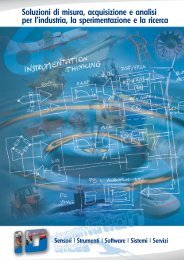
![98L!%$5 gYf]Yg - INSTRUMENTATION DEVICES](https://img.yumpu.com/50611686/1/184x260/98l5-gyfyg-instrumentation-devices.jpg?quality=85)
